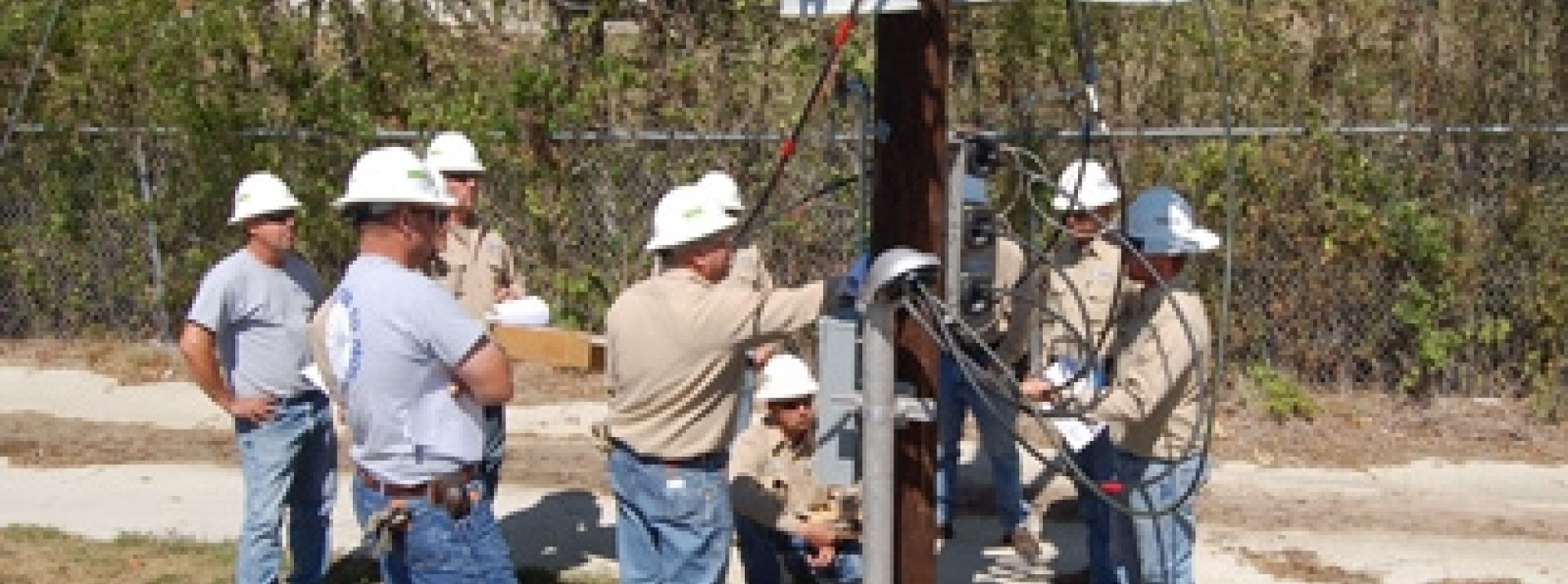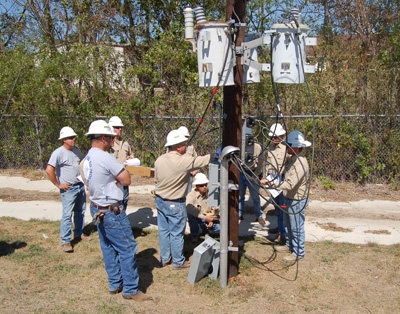
Understanding OSHA Electric Power Training Requirements

Are your employees performing work on or near electric power generation, transmission or distribution facilities? If so, whether they are performing electrical or nonelectrical work, electrical training is required. The training provided must ensure employees can identify electrical hazards and employ safe work methods to remove or control the hazards for their safety.
Covered Work
To simplify the application of OSHA 29 CFR 1910.269 and 1926 Subpart V, many companies use the term “covered work,” which includes work areas with electrical system hazards. For example, the construction of a power plant is the same as general building construction until the plant begins startup and commissioning. Once electrical systems are started, the job tasks become covered work due to the additional electrical system hazards.
Another example is the construction of a substation. Substation construction is similar to general building construction until the substation becomes energized or is being built in an area with transmission lines. Consider the difference between a substation built in an open field with no transmission lines and a substation built under transmission lines. Although each substation has hazards, the substation under the transmission lines has electrical hazards that would not be found in the substation built in an open field. The substation built under transmission lines is considered covered work due to the electrical system hazards.
Training or Qualification?
Employees must demonstrate proficiency in their work practices before training is considered complete. Training without demonstrated proficiency does not equal qualification. Employees in training must be under direct supervision until they have demonstrated proficiency. Additionally, although OSHA does not require documented training, it is always a good practice to document training and completion of demonstrated proficiency.
Employees can be qualified for some tasks and unqualified for others. Qualification requirements are based on the job tasks performed, such as a meter technician installing a new meter, a service technician connecting a new service, a relay technician reprogramming a relay, a lineworker re-conductoring an existing energized line or a distribution operator performing a supervisory control and data acquisition (SCADA) operation. Each of these employees performs different electrical job tasks with different hazards and electrical qualification levels. Distribution operators typically do not perform field work, but they regularly de-energize and energize electrical systems via SCADA operations. SCADA operations directly affect field personnel, so it is imperative they are included in the electrical qualification process.
Qualification Requirements
“Qualified” means one who, by possession of a recognized degree, certificate or professional standing, or by extensive knowledge, training and experience, has successfully demonstrated his or her ability to solve or resolve problems relating to the subject matter, the work or the project.
Electric power standards require all employees to be trained in safety-related work practices, safety procedures and emergency procedures that pertain to their job assignments. The standards further require qualified electrical employees to be trained and competent to:
• Distinguish exposed live parts.
• Identify nominal voltage of exposed live parts.
• Know minimum approach distances (MADs) for the voltage incurred and how to successfully maintain MADs from exposed live parts.
• Know how to use special techniques, personal protective equipment, insulating and shielding materials and insulating tools to successfully work on or near exposed live parts.
• Recognize electrical hazards and successfully control or avoid the hazards when working on or near exposed live parts.
So, who qualifies the qualifier and who is responsible for ensuring employees successfully demonstrate proficiency to complete their training? The employer has the responsibility to develop an effective process to evaluate if employees comprehend training instruction and can proficiently perform the necessary work practices. The process normally includes assigning qualified managers, supervisors or training staff as the qualifying entity.
Retraining Requirements
Retraining or additional training is required when an employee has not completed the job task within one year; he or she is not complying with safe work practices; new technology or new equipment is introduced into the workplace; or the employee must engage in work practices not normally used during his or her regular job duties.
Risk Assessment
OSHA requires the employer to assess the degree of risk associated with each job task and provide training appropriate for the exposure. Determining the degree of risk is subjective, so it is extremely important for organizations to have a structured process in place. The process must ensure employees can recognize hazards and take reasonable measures to avoid or adequately control the hazards. For example, a communication technician installing a new phone line inside an energized substation does not have the same electrical exposure risk a substation technician does when troubleshooting electrical equipment. The degree of risk should be evaluated for each of these job tasks and appropriate training should be developed to mitigate risk.
Many organizations use a job hazard analysis (JHA) to develop procedures to identify hazards and to develop a mitigation strategy to reduce or eliminate hazards. A well-developed JHA examines each step of a job, identifies existing or potential hazards with each step and determines the appropriate method to remove or reduce the hazards identified in each step. JHAs can also be used to determine if your job training content is appropriate and for retraining when an employee has not performed a job task within the previous year.
Job Substitution
Caution should be exercised when employees are substituted in jobs they have not been qualified to perform, such as when, for example, a meter technician responds to a trouble call with a lineworker to comply with OSHA’s two-employee rule. The meter technician would not have to be qualified to the same level as the lineworker; however, he or she would need to meet qualification requirements and demonstrate proficiency as they relate to line work, including but not limited to:
• How to identify and stay safely protected from exposure to energized parts and step and touch potentials.
• How to maintain appropriate MADs from energized parts.
• How to safely de-energize lines and/or equipment in an emergency.
• How to use insulating tools and equipment for rescue.
• How to safely implement emergency procedures including pole-top or bucket rescue procedures as needed.
Nonelectrical Work
As previously mentioned, electric power standards require all employees to be trained in safety-related work practices, safety procedures and emergency procedures that pertain to their job assignments. “All employees” not only relates to employees performing covered work, but also to employees who must access areas restricted to qualified employees to perform nonelectrical work. Examples of employees who access these restricted areas include an employee spraying herbicides around underground enclosures, a warehouseman delivering substation equipment inside an energized substation and a maintenance employee replacing danger signs inside an energized substation. Each of these nonelectrical employees faces potential electrical hazards and risks associated with their job tasks that must be identified. Unfortunately, nonelectrical employees are many times exposed to electrical hazards they do not know exist. Employers must train these nonelectrical employees as qualified employees to enter and work within restricted areas. Training does not need to be as comprehensive as electrical qualification training, but at a minimum employees must know:
• What is safe to touch and what is not.
• The maximum voltage in the area.
• MADs for unqualified employees as well as the techniques required to maintain those distances. Note: MADs can be found in OSHA 1910 Subpart S.
• How to recognize and properly use protective equipment for their safety.
• How to recognize electrical hazards and the techniques to be used to control or avoid them.
Program Effectiveness
Training programs developed to meet electric power standards must be evaluated regularly to ensure they are providing appropriate instruction for safe job performance. OSHA states in the information booklet “Training Requirements in OSHA Standards and Training Guidelines” that training should have, as one of its critical components, a method of measuring effectiveness. An evaluation will help employers and supervisors determine the amount of learning achieved and whether an employee’s performance has improved on the job. If, after evaluation, it is clear that training did not give the employees the level of knowledge and skill that was expected, it will be necessary to revise the training program or provide periodic retraining to ensure employees can demonstrate proficiency as required.
Summary
Well-developed, well-executed training is extremely important for every job classification. Employees must be able to comprehend the training provided and proficiently perform the required work for training to be complete. The time taken to ensure training is appropriately developed and completed will equate to a well-trained, safe employee.
About the Author: Pam Tompkins, CSP, CUSP, is president and CEO of SET Solutions and a 37-year veteran of the electric utility industry. She is a founding member of the Utility Safety & Ops Leadership Network and presently serves on the executive board. Tompkins has authored and presented technical papers on high-voltage electrical safety issues at iP conferences, IEEE workshops, ASSE conferences and for many other organizations. She is an OSHA-authorized instructor who specializes in helping small- to medium-size electric power organizations in the U.S. and abroad comply with today’s safety and training requirements.